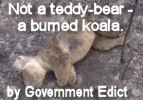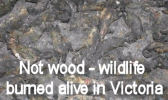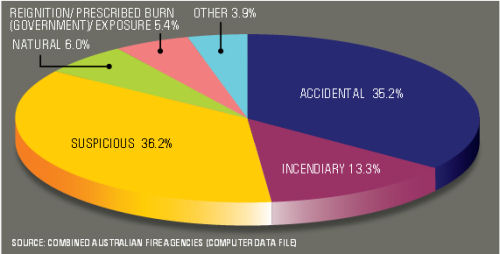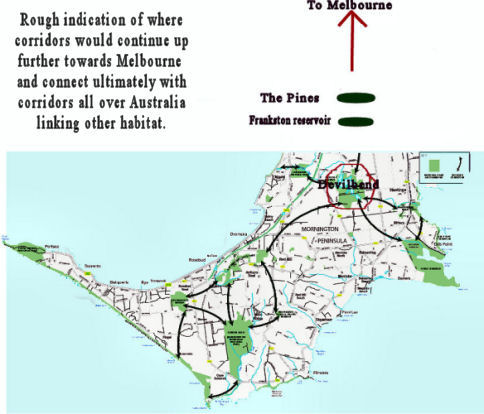Are Victorian governments trying to get rid of Victorian wildlife on purpose?

 Video inside. This article is about the effects of 390,000 ha of native vegetation targeted to be burned every year in Victoria, Australia's most cleared state. The video inside this article documents how vast numbers of Australian wildlife are burned alive in scientifically dubious prescribed burns, mandated by the Victorian Government. It asks whether the cruel and avoidable fate of many wildlife in prescribed burns is really protecting human lives and assets or merely a way of meeting an arbitrary target. Others would be much harsher and say that this may be a calculated strategy to rid the state of wildlife in addition to an apparently deliberate failure to cooperate with wildlife activists in making easily protected wildlife corridors to connect viable habitat.[1]
Video inside. This article is about the effects of 390,000 ha of native vegetation targeted to be burned every year in Victoria, Australia's most cleared state. The video inside this article documents how vast numbers of Australian wildlife are burned alive in scientifically dubious prescribed burns, mandated by the Victorian Government. It asks whether the cruel and avoidable fate of many wildlife in prescribed burns is really protecting human lives and assets or merely a way of meeting an arbitrary target. Others would be much harsher and say that this may be a calculated strategy to rid the state of wildlife in addition to an apparently deliberate failure to cooperate with wildlife activists in making easily protected wildlife corridors to connect viable habitat.[1]
The Labor Government in Victoria created these machinally destructive laws after the 2009 bushfires, but the Liberal Government has not questioned them. Those currently heading the Victorian animal holocaust are Dennis Napthine, Premier of Victoria (denis.napthine [ AT ] parliament.vic.gov.au),
Ryan Smith, Environment Victoria Minister (ryan.smith [ AT ] parliament.vic.gov.au) and
Peter Walsh Minister for Agriculture (peter.walsh [ AT ] parliament.vic.gov.au).

Government burning off decisions arising from the bushfire commission seem mostly based on spin. They do not acknowledge in their methods to avert bushfires the predominant role of humans in starting them. Nature accounts for only about 6% of fires, mostly in the form of lightening. Ninety point nine per cent (90.9%) of vegetation fires are caused by humans through arson (35.2), through 'accidents' (36.2%), by 'incendiary' (? explosions etc) (13.3%), and through prescribed burns reigniting (5.4%). (3.9% are described as 'other'.)
"Bushfire, arson, what do we know now?" (the source of the above graph and figures) is a Productivity Commission report on the role of arson in creating fires. As we might expect of the economic technocracy, one of their recommendations is prescribed burn-offs to limit the arsonist's bang for his/her buck! In other words, do the job for them? Absolutely no regard or even a thought for the living creatures that suffer. The authors note that it is hard to stop arson in large vegetated areas. We note, however, that there has been a huge reduction in parks and forest staff on the ground, like rangers, since the Kennett government 1992-1999, with Labor governments continuing this folly.
Shooters encouraged in parks, but not wildlife carers
Whilst governments are gung-ho to allow shooters into national parks to 'control pests', what about compensating wildlife activists and carers who are willing to roster themselves in forests during the fire-season and to monitor animal welfare and visitor activity, day and night if necessary? People who care for injured wildlife and love the bush are very unlikely to set fire to habitat.
Faulty bushfire management compounds faulty climate change management
The values of the Liberal Government avoid the issue of climate change. Their population growth and development policies (like the Labor government's before them, despite the rhetoric) actively increase high carbon-emission producing activities and drying and warming of land. Much of Australia's carbon emissions come from land-clearing, but in Victoria (and Australia) the government is encouraging more new development, and consequently more land-clearing. As well, intensification of development means that people are confined to small airless and eaveless appartments which can only be cooled by air-conditioners, which put heat into the air outside and demand more coal-fired electricity to run. Victoria's grotesque 'planning policies' increase local heat island effect and the overall risk of the climate heating and drying. We note that Victoria is soon to subject VCAT to committee regulation that will see even less control over the 'planning' that is overrunning our democracy and heating our environment.[3]
The mass media and government have avoided acknowledging the demonstrable fact that old growth forests burn much less than new or 'managed' forests. New forests and plantations dry through thinning or through repeated burnoffs which then favour combustible vegetation that survives fires, thus creating a man-made fire-vulnerable landscape and reduction to inland rainfall. The prescribed annual burn-off target greatly increases the drying of vegetated land and vegetation kinds. Trees not only create local 'heat islands' but vast old-growth forests cool vast portions of the environment as well as efficiently regulating below-ground and above ground hydration through transpiration.
For those who were in Victoria during the 2009 fires, and remember the heat leading up to the fires, the active promotion through legislation of these drying factors (although in guise of fire-precautions) is insane. At best it appears like gross incoordination of knowledge and policy; at worst it seems quasi-homicidal.
Government by the ethically bereft in Victoria and Australia
It is as if we are governed by a self-appointed moneyed caste which has lost all respect for nature, other species and the citizens of Victoria themselves. The environmental laws are flouted [2]and then, when attention is drawn to this, our corrupt parliaments simply change the laws.
For those of us who grew up in a social environment that enjoyed the outdoors and strongly valued passive interaction with native wildlife, with a culture of wildlife protection and respect, this is shocking. We realise that we are ruled by a planning technocracy that has no higher human values, makes empty promises, speaks in cliches, and makes laws to advantage its members.
It has taken many of us decades to accept that this is really what is happening. At best we are witnesses to great callousness, at worst we are witness to the construction by elites of a kind of civilisation that is only concerned with enriching a small elite at the expense of their fellows and the total destruction of the natural world.
The people responsible are obviously not able to work out the ultimate consequences of their policies, which will see a so-degraded Austrlaia that survival for most, if not all, will become doubtful. They are also not scientists, except in the technologies that further their immediate wealth. They have no humane philosophies. If they are religious, it is with dogmas that blind them to consequences and help them to further their own immediate interests. They are like Steven King's Tommyknockers, whom education has equipped with "a limited form of genius which makes them very inventive, but does not provide any philosophical or ethical insight. Instead, it provokes psychotic violence."[4]
This class is also ruling all states of Australia.
Inquiry into 2009 bushfires
The article below is a report on the inquiry into the 2009 Victorian bushfires, which were among the most frightening ever, occurring in deadly temperatures in the mid-forties. It shows the typical approach of the mainstream media, which always backs the status quo and attributes science and foresight to the establishment in its conditioning comments about how 'scientific evaluations have always been part of intelligent fuel reduction strategy' and its illogical conclusion that 'an effective wildfire control strategy must attempt to control fires throughout the forests. The paragraphs quoted below, however, also contain telling comments from environmentalists, but these paragraphs were right at the end of the full article, where most people never read. To consign these important observations to the end of the article, naturally diminishes their value in the readers' eyes. Also, note the use of 'experts' in the Royal Commission. Experts are usually part of the establishment. If you are not part of the establishment or disagree with it, then newspapers are unlikely to call you an 'expert'.
"Environmentalists, who for years have opposed fuel-reduction burns on the grounds that they damage the environment, have taken a new tack. The Greens, for example, now claim that they never opposed prescribed burning, but wanted a scientific evaluation of each burn conducted before it was approved, to ensure the survival of fauna and flora.
While this sounds reasonable, the fact is that these considerations have always been part of an intelligent fuel-reduction strategy, which must recognise that fires have been a natural feature of the bush, and it can be assumed that fauna and flora are adapted to survive low-to-moderate intensity fires.
[Candobetter comment: The huge arbitrary annual target promotes a regularity of holocaust that was never present in the environment where Australian animals evolved. Furthermore, this pyromaniacal target occurs in the most cleared state and where wildlife are threatened by many other intensifying and expanding processes. To cite evolutionary theory under these conditions is inappropriate and has grave consequences, as we see in the film above.]
Another line of attack, put forward by some environmental groups in central Victoria, is that the DSE should be setting fire to grass and weeds in close proximity to housing, rather than burning forests.
A spokesman for the groups said, "We cannot understand why DES fuel-reduction teams keep burning public forest blocks, when the dangerous areas closer to settlements are neglected." (Bendigo Advertiser, March 24, 2010).
Another member claimed that the DSE had produced no research analysing the effect of fuel-reduction burns on central Victoria's box-ironbark forests. The groups had adopted the motto, "Hazards not Hectares", to emphasise the need for burns in high-risk areas, rather than large areas of bush.
However, an effective wildfire control strategy must attempt to control fires throughout the forests, without neglecting high-risk areas close to human habitation. " (Source: "BUSHFIRES: Victoria changes tack on fuel-reduction burns," by Peter Westmore, News Weekly, April 17, 2010
NOTES

[1] Such as those of Maryland Wilson, Malcolm Legg and Hans Brunner http://candobetter.net/?q=node/1012 and http://candobetter.net/?q=taxonomy/term/73over years on the Mornington Peninsula, attempting to link Greensbush National Park with Devilbend Reservoir, sundry then extant green paces and Frankston Reservoir. All eroded by development and then all prospects of a corridor completely destroyed - some would say gratuitously - by Peninsula Link - which could have provided many underpasses and overpasses but only provided one, in the Pines Flora and Fauna reserve, where the local Frankston Council then failed to use money allocated by government to install a predator proof fence to protect the local bandicoot population, which then became extinct. Now our only hope is a southern brown bandicoot program in the Werribee Zoo. Imagine! Needing a zoo to preserve this once common animal. Everything, from kangaroos to platypuses is now stuck in the remaining isolated and dwindling patches of habitat on Mornington Peninsula, which has been targeted for growth since Jeff Kennet made it part of Greater Melbourne. Instead of a green peninsula biosphere once touted, the Victorian government intends to build new roads and railway down to Hastings Port, of which 400 ha it then means for intensive industrial development.
[2]Victorian Fauna and Flora Guarantee Act
Auditor General's reports
[3] "GENERAL BUSINESS
7 JULY 2014
10. CHANGES TO THE VICTORIAN AND CIVIL ADMINISTRATIVE (VCAT) ACT
Planning Appeals Coordinator: Gareth Gale
General Manager Planning & Development: Stuart Draffin
PURPOSE
The purpose of this report is to brief Councillors on changes made by the Victorian Civil and Administrative Tribunal (VCAT) Amendment Bill 2014.
BACKGROUND
On 1 April 2014, the VCAT Amendment Bill 2014 received Royal Assent, and became effective on 2 June 2014. No community consultation occurred as part of this Amendment.
DISCUSSION
The Victorian Civil and Administrative Tribunal Amendment Bill 2014 contains substantial reforms relevant to the planning jurisdiction.
Most significantly, the reforms would enable the Tribunal to:
1. Invite a responsible authority to reconsider its decision at any time in a review proceeding
2. Make an order in relation to fees (including application and hearing fees), separate from its power to award costs
3. More actively manage the use and giving of expert evidence in proceedings
4. Make an order removing a person as a party to a proceeding if it considers that:
•??the person's interests are not affected by the proceeding; or
•??the person is not a proper or necessary party to the proceeding
5. Delegate certain functions of the Tribunal (such as making procedural orders or consent orders) to its registrars.
It is the first two reforms that are likely to be of most significance to Council. Below is a summary of those two proposed reforms.
New section 51A - Tribunal May Invite Decision-Maker to Reconsider Decision
In the context of the planning jurisdiction, this new provision would enable the Tribunal to invite a responsible authority (usually Council) to reconsider its decision at any time in the proceeding. The new section provides that on receiving the invitation to reconsider, the responsible authority may:
•??Affirm the decision
•??Vary the decision
•??Set aside the decision and substitute a new decision for it.
The new provision requires the Tribunal to ensure that, as far as possible, a proceeding's priority is not affected by inviting the responsible authority to reconsider its decision (unless the parties consent). As a consequence, the Tribunal may specify a timeframe within which a responsible authority may reconsider its decision.
One possible opportunity for Council to reconsider its decision might be following mediation and/or the amendment of plans. However, this process only seems warranted in order to avoid a hearing extending across multiple days – cases which are generally contained within the Major Cases List. Given there is clear intent in the new provisions to ensure a proceeding is not delayed further, coupled with the fact that all Major Cases List applications have hearings listed only six weeks after any mediation, it is difficult to contemplate under what circumstance this process will be useful.
It is further noted that Council already has the opportunity to reconsider its position during a VCAT process. As such, this change to the VCAT Act might not offer any new real change other than introducing a more formal mechanism to do so. This new process raises a number of procedural questions which are yet to be understood.
New Section 115 – New Power to Make Orders in Relation to Fees
This section provides that the Tribunal may, at any time, make an order that a party to
the proceeding:
•??Reimburse another party the whole or any part of any fee paid by that other party in the proceeding;
•??Pay, on behalf of another party, the whole or any part of any fee that may be required to be paid in the future by that other party in the proceeding;
•??Reimburse another party the whole or any part of any fee that may be paid in the future by that other party in the proceeding; and
•??Require a party to pay the whole or any part of a fee in future in the proceeding.
The key area that this could be useful for Council is in Enforcement Order Applications (EAO’s). Given EAO’s are generally only made in the situation where Council is forced to do so, the Tribunal could award the reimbursement of the $802 fee to Council.
SUMMARY
The new changes to the VCAT have been introduced with little forewarning or consultation.
The implications of the changes, and particularly those at the new section 51A, are unclear amongst those working within the planning profession. At this stage, there appears little opportunity to enact this new provision, particularly given there is clear intent in the new provisions to ensure a proceeding is not delayed further.
The new changes will be monitored to better inform our understanding of how they will affect Council and other stakeholders.
HUMAN RIGHTS CONSIDERATION
The recommendation complies with the Victorian Charter of Human Rights and
Responsibilities Act 2006.
RECOMMENDATION
That Council note this report."
[4] Quote from Wikipedia summary of the plot of Steven King's The Tommyknockers, http://en.wikipedia.org/wiki/The_Tommyknockers

Recent comments